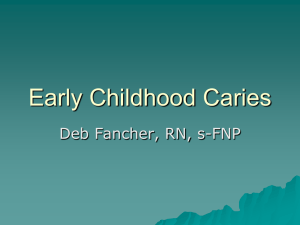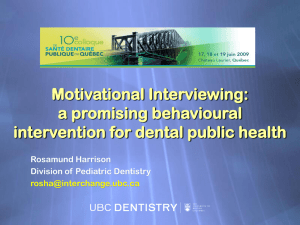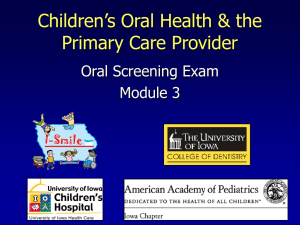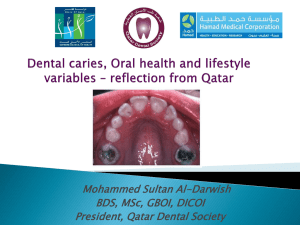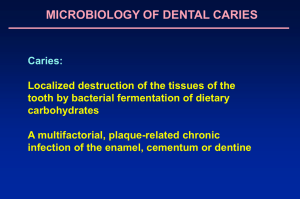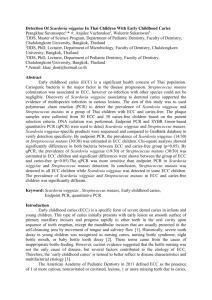Epidemiology and Risk Factors for Early Childhood Caries
advertisement
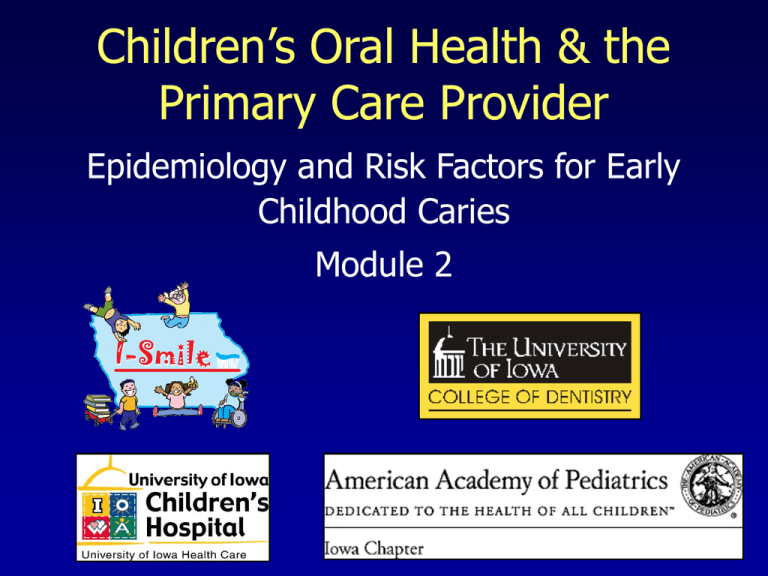
Children’s Oral Health & the Primary Care Provider Epidemiology and Risk Factors for Early Childhood Caries Module 2 Module 2 Objectives: Discuss the epidemiology of Early Childhood Caries (ECC) Discuss the factors that place children at higher risk for developing ECC Discuss clinical findings that are predictive of high ECC risk How Do Cavities Develop? Streptococcus mutans Carbohydrates Acid formation Demineralization Tooth destruction Teeth Sugar Decay Bacteria How Do Cavities Develop? Streptococcus mutans Carbohydrates Acid formation Demineralization Tooth destruction Teeth Sugar Decay Bacteria Sugar Consumption & Risk of ECC pH Acids persist for 20-40 minutes after eating Frequency of sugar ingestion more important than quantity Safe zone Danger zone Time 6 Bottle 7 Breakfast 8 9 Snack 10 11 12 Sippy-cup Sippy-cup J. Douglass BDS, DDS 1 Lunch H. Silk MD A. Douglass MD Risk Factors for Early Childhood Caries (ECC) Bottle-feeding: Risk of ECC Studies show low cariogenicity of bovine milk Phosphoproteins in milk inhibit enamel dissolution Cariogenicity increases when bovine milk serves as a vehicle for sugary substances Breastfeeding: Risk of ECC Epidemiological studies of breastfeeding & ECC are rare Possibility that deleterious dietary practices other than breastfeeding cause ECC Breast milk alone is not cariogenic Breast milk becomes highly cariogenic in the presence of other sugars Risk Factor for ECC: Nocturnal Feeding Nocturnal feeding plays a role in caries development When practiced for prolonged periods of time Related to reduction of salivary flow during sleep Highest risk: Nighttime sugary liquids and/or prolonged on-demand nighttime breastfeeding combined with poor oral hygiene Risk Factors for ECC: Juice and Sugary Beverages Ad lib consumption from bottle or sippy-cup throughout the day or from a bottle taken to bed: Leads to frequent exposure of teeth to carbohydrate, contributing to caries Linked to malnutrition & short stature Replaces more nutritious foods & blunts appetite Fruit juices offer no nutritional benefits over whole fruit Sugary beverages have no nutritional value In older children: sugary beverages (especially soda) also contribute to the epidemic of obesity Risk Factors for ECC: Cariogenic (Sugary) Snacks Daily frequent exposure to sugary foods is associated with increased ECC risk. Sugary foods that are especially cariogenic: Sticky foods that are retained in the mouth for prolonged periods of time & not easily washed out by saliva Consumed as between meal snacks (>2X/day) Risk Factors for ECC: Transmission of Streptococcus mutans (SM) Early contamination with SM increases ECC risk Mothers with high levels of SM tend to have: High level of decay Poor oral hygiene Frequent sugar consumption/snacking Children with high levels of SM High dental caries rates within family members increases child’s risk Practices that Allow Transmission of Streptococcus mutans Risk Factor for ECC: Poor Oral Hygiene Visible plaque correlated with high levels of Streptococcus mutans Infants & Toddlers: Visible plaque is an indication of poor & inconsistent daily oral hygiene Risk Factor for ECC: Inadequate Fluoride No regular use of fluoride toothpaste Drinking non-fluoridated water Risk Factor for ECC: Children with Special Health Care Needs (CSHCN) More caries (treated and untreated) More missing teeth Poor oral hygiene due to behavior problems Higher prevalence of gingivitis and periodontal diseases Inadequate dietary habits Risk Factor for ECC: Children with (CSHCN) Enamel Hypoplasia More difficulty obtaining dental care than any other population Frequent exposure to sugary medications Medication side effects (xerostomia: salivary flow) Compromised immune system Enamel hypoplasia Risk Factor for ECC: Deleterious Habits During Pregnancy Inadequate prenatal care Drug abuse Genitourinary or oral infections (periodontal disease) Alcohol or tobacco use are associated with: Premature and/or Low Birth Weight Baby Enamel Hypoplasia Prematurity is also associated with Enamel Hypoplasia Risk Factor for ECC: Socioeconomic Status Ethnic & Cultural factors Children from families with: Low-income Low educational levels Low dental health literacy are more likely to have caries What Clinical Findings Are Predictive of High Caries Risk? Previous Caries Experience One of best predictors of future caries (Reisine et. al, 1994) For children under age 5, a history of decay should automatically classify a child as high risk Not useful caries-risk predictor for infants and toddlers (not enough time for ECC to be expressed) Visible Plaque One of the best predictors of future caries risk in young children Screening for visible plaque is relatively easy and inexpensive Dental Plaque White Spot Lesions Initial stage (precursor) of the caries process Equivalent to caries for infants and toddlers Often observed at the gum line and accompanied by plaque and bleeding gums Chalky, white spots on primary teeth are demineralized areas and are considered early decay From White Spots to Frank Caries Enamel Defects & Stained Pits and Fissures Enamel hypoplasia Stained pit and fissure surfaces of primary teeth Consider both indicative of increased caries risk Enamel Hypoplasia Stained Pits and Fissures Perceived Risk by Health Care Professional Experienced practitioners are reasonably able to predict caries risk with high levels of accuracy Presence of Braces and Oral Appliances Caries Risk Assessment and Management Any observable decay or demineralization (white spots): - Refer for dental care as soon as possible Any factors on the oral screen or parent interview that increase the child’s risk for caries: - Refer for dental care Uncertain caries risk: - Refer for dental care Refer to I-Smile Coordinator for care coordination & to ensure that dental care is established Re-assess to ensure the child has been evaluated by a dentist & has established regular dental care & a dental home I-Smile Coordinators I-Smile coordinators are dental hygienists who serve as prevention experts and liaisons between families, health care professionals, and dental offices to ensure completion of dental care. Coordinators are located in regional public health agencies and provide local community support throughout Iowa. A coordinator can: • Assist with dental referrals for young children. • Provide Medicaid dental billing information. • Offer education for healthcare professionals regarding children’s oral health, including screening and fluoride varnish training. I-Smile Coordinator contact information can be found at: www.idph.state.ia.us/hpcdp/oral_health.asp or I-Smile hotline 1-866-528-4020 Summary: Oral Health Module 2 Dental caries develop in the presence of teeth, bacteria & sugars Human & bovine milk have low cariogenicity Ad lib use of a sippy cup or bottle filled with juice or sugary beverages is a significant risk factor Previous caries & visible plaque are the best predictors of future caries for young children Enamel defects & stained pits or fissures increase risk of caries

